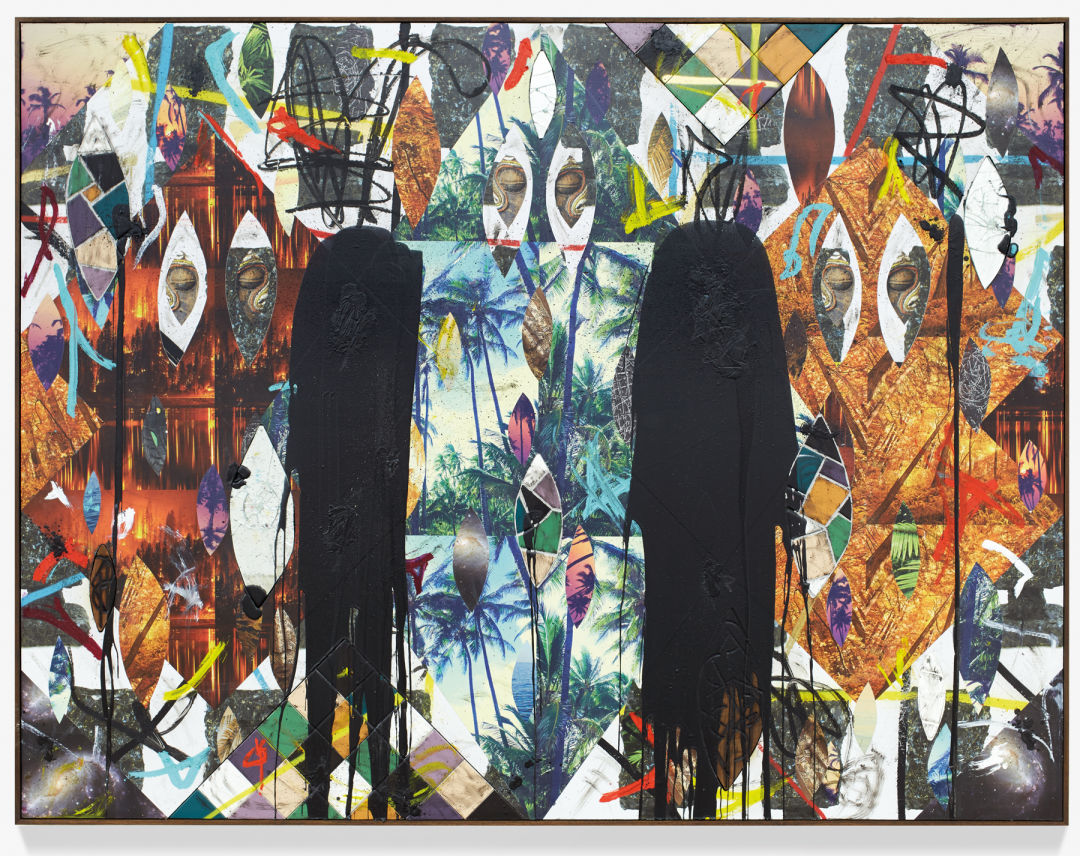Aspen Art Museum Offers Exhibits by Rashid Johnson and John Armleder

Rashid Johnson, Untitled Escape Collage, 2019
Image: Courtesy Aspen Art Museum
At its grandest, art acts as an agent of change and a direct path to truth, serving as a language that accommodates experience and expands our world view. Through a pair of shows that opened this summer, the Aspen Art Museum presents two artists, Rashid Johnson and John Armleder, whose work embodies this definition of art.
Johnson’s solo exhibition, The Hikers (through November 3, presented in collaboration with Mexico City’s Museo Tamayo), showcases his expansive artistic range while distilling the abstract quality of truth-telling. The elements include three large-scale, collage-based narrative paintings; a video piece (shot in Aspen in May); and two live performances of his first-ever choreographic work, incorporating classical ballet and modern movement, that took place July 3.
The Chicago-born artist catapulted to fame in 2001 as part of the critically acclaimed exhibition Freestyle at Harlem’s Studio Museum. Highlighting 28 emerging African American artists, the exhibit also more widely introduced the paradoxical phrase “post-black,” which describes a genre of art that places the black experience at its epicenter while simultaneously rejecting the notion that race matters.
To express the complexities of the African American experience, Johnson employs almost every type of media, material, and discipline, including photography, sculpture, painting, drawing, collage, installation, video, and—most recently—film (making his directorial debut with Native Son, which debuted at the Sundance Film Festival in January). His collage paintings incorporate everyday materials he associates with his childhood—ceramic tiles, fabric, vinyl flooring, shea butter, and tropical plants—elevating these humble objects into symbols that reflect an African American intellectual history and cultural identity. In doing so, he provides a visceral understanding of the black experience that defies language. But, through his work, Johnson also manages to break free of the inherently divisive notion of racial identity.

John Armleder, Untitled, 2008
Image: Courtesy Photo
Swiss artist John Armleder has long added to the essential discourse on contemporary art by allowing technique to do the talking. The exhibition Spoons, moons, and masks (through October 27 ), curated by museum director Heidi Zuckerman and her team, showcases 14 of his seminal Pour and Puddle paintings, including a new site-specific work created on the exterior wall of Gallery One.
Evoking the works of modern masters like Jackson Pollock and Larry Poons, Armleder’s pieces contrast flow and stasis. Just like it sounds, he creates the Pour paintings by letting different colors of paint flow down a vertical canvas, like taffy rainbows. For the Puddle paintings, Armleder allows the colors to pool and spatter in multicolor maelstroms on canvases he lays horizontally on the studio floor.
By conflating art and design, Armleder offers endless possibilities for interpretation. His vibrant canvases evoke a spontaneous response, at times driving a viewer to want to make sense of the patterns, at other times calling attention to the artist’s technique.
Within the range of pieces between the two exhibitions, there’s much to capture an art enthusiast’s interest. “We promise to show you something you’ll like,” says Zuckerman. “The greatest expectation for any exhibition lies in its possibility to present us with new perspectives, experiences, inspiration, solace, reflection, and even the possibility for transcendence in some way.”













































